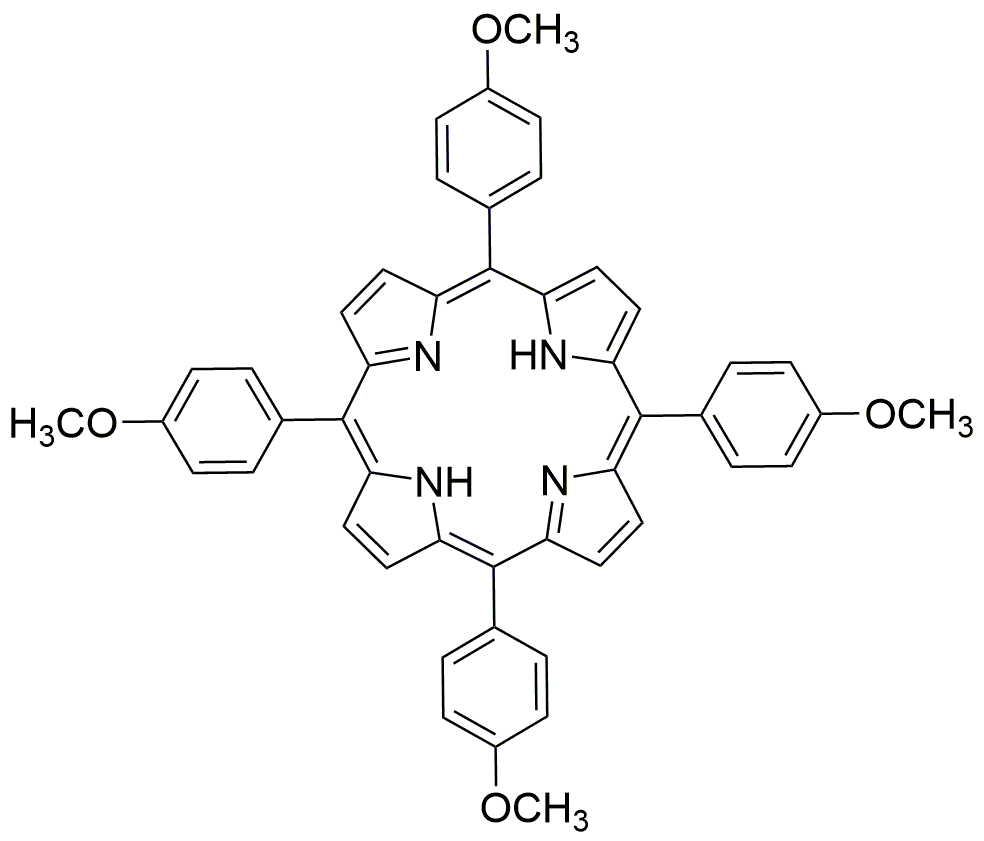5,10,15,20-Tetrakis(4-methoxyphenyl)porphyrin is widely utilized in research focused on:
- Photodynamic Therapy: This compound is effective in treating certain cancers by generating reactive oxygen species when exposed to light, helping to destroy cancer cells while minimizing damage to surrounding healthy tissue.
- Solar Energy Conversion: It plays a key role in the development of organic solar cells, enhancing light absorption and energy conversion efficiency, making renewable energy sources more viable.
- Fluorescent Probes: Used in biological imaging, it serves as a fluorescent marker, allowing researchers to visualize cellular processes and track biomolecules in real-time.
- Catalysis: This compound is employed in various catalytic reactions, improving reaction rates and selectivity in organic synthesis, which is crucial for pharmaceutical and chemical manufacturing.
- Sensor Technology: It is integrated into sensor devices for detecting environmental pollutants, providing a sensitive and selective means of monitoring air and water quality.
Informations générales
Propriétés
Sécurité et réglementation
Applications
5,10,15,20-Tetrakis(4-methoxyphenyl)porphyrin is widely utilized in research focused on:
- Photodynamic Therapy: This compound is effective in treating certain cancers by generating reactive oxygen species when exposed to light, helping to destroy cancer cells while minimizing damage to surrounding healthy tissue.
- Solar Energy Conversion: It plays a key role in the development of organic solar cells, enhancing light absorption and energy conversion efficiency, making renewable energy sources more viable.
- Fluorescent Probes: Used in biological imaging, it serves as a fluorescent marker, allowing researchers to visualize cellular processes and track biomolecules in real-time.
- Catalysis: This compound is employed in various catalytic reactions, improving reaction rates and selectivity in organic synthesis, which is crucial for pharmaceutical and chemical manufacturing.
- Sensor Technology: It is integrated into sensor devices for detecting environmental pollutants, providing a sensitive and selective means of monitoring air and water quality.
Documents
Fiches de données de sécurité (FDS)
La FDS fournit des informations de sécurité complètes sur la manipulation, le stockage et l’élimination du produit.
Spécifications du produit (PS)
Le PS fournit une description complète des propriétés du produit, notamment sa composition chimique, son état physique, sa pureté et les exigences de stockage. Il détaille également les plages de qualité acceptables et les applications prévues du produit.
Certificats d'analyse (COA)
Recherchez des certificats d'analyse (COA) en saisissant le numéro de lot du produit. Les numéros de lot et de lot se trouvent sur l'étiquette d'un produit, après les mots « Lot » ou « Lot de fabrication ».
Numéro de catalogue
Numéro de lot/série
Certificats d'origine (COO)
Ce certificat d'exploitation confirme le pays dans lequel le produit a été fabriqué, et détaille également les matériaux et composants utilisés et s'il est issu de sources naturelles, synthétiques ou autres sources spécifiques. Ce certificat peut être requis pour les douanes, le commerce et la conformité réglementaire.
Numéro de catalogue
Numéro de lot/série
Fiches de données de sécurité (FDS)
La FDS fournit des informations de sécurité complètes sur la manipulation, le stockage et l’élimination du produit.
DownloadSpécifications du produit (PS)
Le PS fournit une description complète des propriétés du produit, notamment sa composition chimique, son état physique, sa pureté et les exigences de stockage. Il détaille également les plages de qualité acceptables et les applications prévues du produit.
DownloadCertificats d'analyse (COA)
Recherchez des certificats d'analyse (COA) en saisissant le numéro de lot du produit. Les numéros de lot et de lot se trouvent sur l'étiquette d'un produit, après les mots « Lot » ou « Lot de fabrication ».
Numéro de catalogue
Numéro de lot/série
Certificats d'origine (COO)
Ce certificat d'exploitation confirme le pays dans lequel le produit a été fabriqué, et détaille également les matériaux et composants utilisés et s'il est issu de sources naturelles, synthétiques ou autres sources spécifiques. Ce certificat peut être requis pour les douanes, le commerce et la conformité réglementaire.


